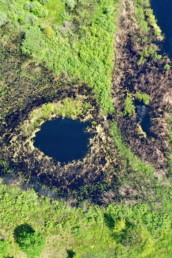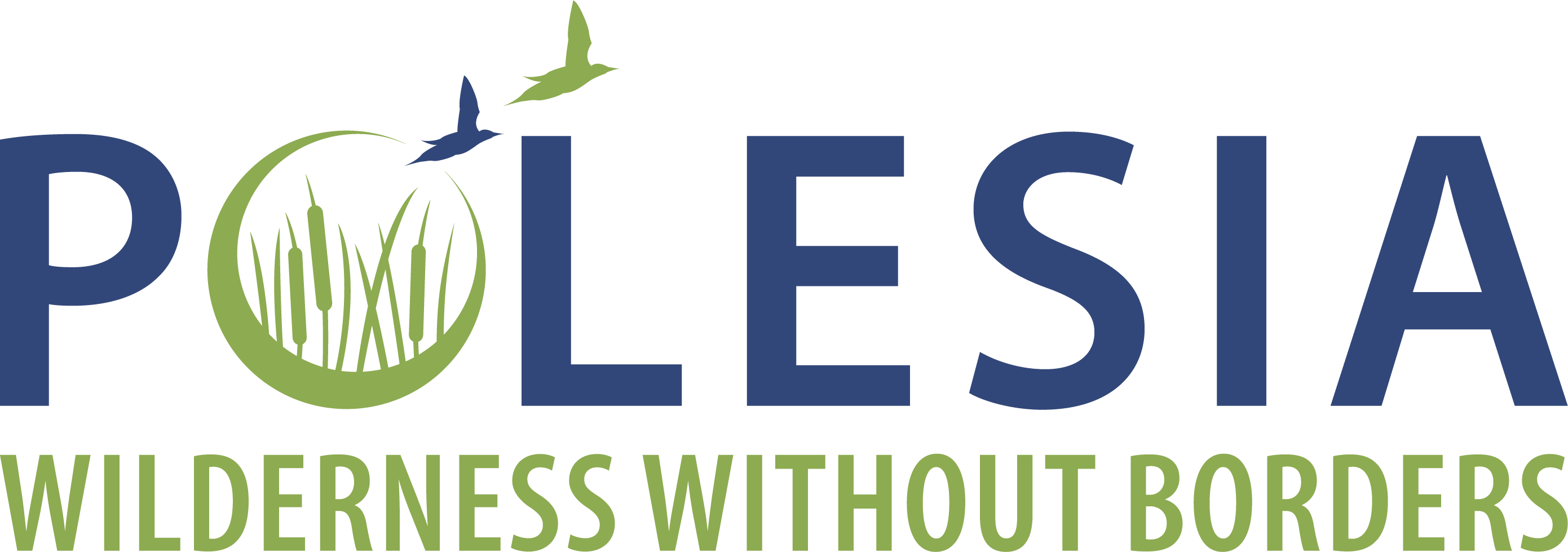Lva Floodplain
The protected area encompasses an extensive tract of deciduous forest situated within the floodplain of the Lva River, positioned between the Garyn River valley and the Almany Mires. This landscape is characterized primarily by waterlogged deciduous forests, interspersed with sedge meadows, mixed herbaceous and cereal meadows, and swamp habitats along the river course.
The Lva River itself is a dynamic system, with a meandering channel measuring between 10 and 25 meters in width. Its flow is occasionally impeded by natural damming and dense vegetation, forming multiple tributaries that contribute to the site’s wetland diversity.
Historical land-use changes during the 1970s and 1980s, including extensive drainage of adjacent swamplands and the construction of a reclamation system in the central area, have significantly altered the site’s hydrology. These interventions have had measurable impacts on wetland function and forest health.
Currently, portions of the reclaimed land are managed for grazing and hay production, while some areas remain under cultivation. Despite these pressures, the site retains a broad spectrum of wetland habitats critical for biodiversity conservation.
Country: Belarus
Area: 2,399.5 ha
National protection status: nature reserve
International protection status:
IBA (BY030) – L'va floodplain (16,854 ha);
Emerald Network* (BY0000049) – Lva Floodplain (17,710.4 ha)
* After denunciation of accession to the Bern Convention on the Conservation of European Wildlife and Natural Habitats, de jure there are no Emerald Network sites in Belarus.
The following description relates to the former Lva Floodplain Emerald Network site.
home to >2%
of the country's Greater Spotted Eagle population
20 key habitats
recognized under the Resolution No. 4 of the Bern Convention
588 species
of vascular plants identified here
Biodiversity and natural values

Habitats
Approximately 20 natural habitat types listed under Resolution No. 4 of the Standing Committee to the Bern Convention have been identified in the area.
Aquatic Habitats
- Floating water-soldier rafts (3150)
- Floating bladderwort colonies (3150)
- Floating Salvinia natans mats (3150)
- Free-floating vegetation of eutrophic
- waterbodies (3150)
- Rooted submerged vegetation of eutrophic waterbodies (3150)
Wetlands and Peatlands
- Transition mires and quaking bogs (7140)
- Beds of large sedges normally without free-standing water (7210)
Woodland Habitats
- Riverine willow woodland (91E0)
- Riverine ash–alder woodland wet at high but not at low water (91E0)
- Sphagnum birch woods (91D0)
- Oak–ash–hornbeam woodland on eutrophic and mesotrophic soils (9170)



Biodiversity
This site is a vital habitat for several globally and nationally endangered species. Notably, it supports over 2% of the country’s Greater Spotted Eagle (Clanga clanga) population; a species recognized as globally threatened.
In addition, around 1% of the national populations of the Terek Sandpiper (Xenus cinereus) and the Hen Harrier (Circus cyaneus) have been recorded breeding here. The area also serves as a breeding ground for other important birds of prey, including the Short-toed Eagle (Circaetus gallicus), Lesser Spotted Eagle (Aquila pomarina), and White-tailed Eagle (Haliaeetus albicilla).
Breeding seasons have been documented for species such as the Great Snipe (Gallinago media), Black-tailed Godwit (Limosa limosa), White-backed Woodpecker (Dendrocopos leucotos), and Azure Tit (Parus cyanus), reflecting the site’s rich avian diversity.
The plant life is equally impressive, with 588 species of vascular plants identified, including six species protected under Belarusian law.
Together, this diverse wildlife makes the area a key site for conservation and biodiversity in the region.
The most important impacts and threats

Meadows overgrowing with scrubs

Dead wood removal, sanitation felling

Old drainage systems
Our activities in the area
As part of the project, the team initiated the designation of a nature reserve covering an area of 2,400 hectares within the Lva River floodplain. All necessary scientific studies and documentation required for the establishment of the reserve were carried out under the project framework.
During this process, rare biotopes and habitats of species listed in the Red Data Book of Belarus were identified and placed under protection. These efforts contribute directly to the preservation of the natural values of the Lva Floodplain Emerald Network site.
Protection and conservation needs
A portion of the Lva River floodplain is currently protected as a nature reserve of local importance, where economic activities are restricted to support biodiversity conservation. In addition, some habitats of protected species and valuable biotopes benefit from the protection provided by local land users.
To enhance the ecological condition and conservation effectiveness in the area, the following steps are recommended:
1. Carry out a detailed inventory of conservation values, including species habitats and natural complexes;
2. Establish special protection zones or plots to safeguard the most sensitive or valuable areas;
3. Implement systematic monitoring of key species, habitats, and ecological processes;
4. Develop a management plan to guide restoration and sustainable land use.
These actions are essential for maintaining the integrity and resilience of the Lva River floodplain and ensuring the long-term protection of its unique biodiversity and wetland ecosystems.





